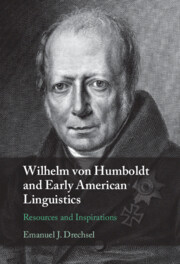Book contents
- Wilhelm von Humboldt and Early American Linguistics
- Wilhelm von Humboldt and Early American Linguistics
- Copyright page
- Dedication
- Contents
- Figures and Tables
- Maps
- Preface
- Acknowledgments
- Part I Wilhelm von Humboldt and the Americas
- Part II The Early Lives of Wilhelm and Alexander von Humboldt
- Part III Wilhelm von Humboldt’s Americanist Linguistics
- 6 First Exposure to American Languages at the Vatican Library in Rome and the Significance of Alexander’s American Resources (1803–1808)
- 7 Expansion and Intensification of Humboldtian Americanist Linguistics
- 8 Les langues du Nouveau Continent
- 9 From the Americas to the Pacific
- Part IV Wilhelm von Humboldt’s Impact on Americanist Linguistics and Anthropology
- Part V Wilhelm von Humboldt as an Americanist Linguist and Anthropologist
- Book part
- References
- Index
9 - From the Americas to the Pacific
Americanist Linguistics as Methodological-Conceptual Midwife to the Study of Malayo-Polynesian Languages (1827–1835)
from Part III - Wilhelm von Humboldt’s Americanist Linguistics
Published online by Cambridge University Press: 11 January 2024
- Wilhelm von Humboldt and Early American Linguistics
- Wilhelm von Humboldt and Early American Linguistics
- Copyright page
- Dedication
- Contents
- Figures and Tables
- Maps
- Preface
- Acknowledgments
- Part I Wilhelm von Humboldt and the Americas
- Part II The Early Lives of Wilhelm and Alexander von Humboldt
- Part III Wilhelm von Humboldt’s Americanist Linguistics
- 6 First Exposure to American Languages at the Vatican Library in Rome and the Significance of Alexander’s American Resources (1803–1808)
- 7 Expansion and Intensification of Humboldtian Americanist Linguistics
- 8 Les langues du Nouveau Continent
- 9 From the Americas to the Pacific
- Part IV Wilhelm von Humboldt’s Impact on Americanist Linguistics and Anthropology
- Part V Wilhelm von Humboldt as an Americanist Linguist and Anthropologist
- Book part
- References
- Index
Summary
With its “emic” underpinnings and multi-faceted comparative principles, Humboldt’s Americanist platform proved suitable for the initial description and analysis of the languages of the Pacific such as Old Javanese and other Malayo-Polynesian languages in their own terms (“inner forms”) in contrast to the unidimensional Sanskrit-derived models by Indo-Europeanists. Humboldt instead concentrated on linguistic-sociohistorical diversity as key notions in the description and analysis of Southeast Asian and Pacific languages, alternative models of language change, including language contact, and complementary historical methodological resources. He did not suggest any common ancestry between the languages of the Americas and the Pacific beyond that of modern humanity; but he merely argued for linguistic processes that applied in the Americas also to hold true in the Pacific or in still other areas, and thus defined a modern anthropologically-based historical linguistics in truly comparative terms with special attention to the analysis of grammar.
Keywords
- Type
- Chapter
- Information
- Wilhelm von Humboldt and Early American LinguisticsResources and Inspirations, pp. 171 - 192Publisher: Cambridge University PressPrint publication year: 2024

